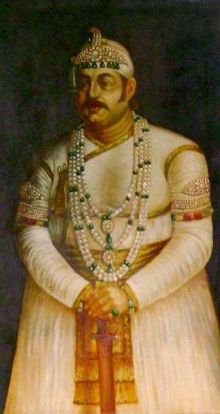Afzal-ud-Daulah
This article needs additional citations for verification. (August 2020) |
Mir Tahniyat Ali Khan Siddiqi Bahadur 5th Nizam of Hyderabad, GCSI | |||||
|---|---|---|---|---|---|
 | |||||
| 5th Nizam of Hyderabad | |||||
| Reign | 16 May 1857 – 26 February 1869 | ||||
| Coronation | 1857 | ||||
| Predecessor | Nasir-ud-dawlah, Asaf Jah IV | ||||
| Successor | Mir Mahboob Ali Khan Siddiqi, Asaf Jah VI Princess Jahandar unisa begum (Lady Viqar ul umrah) Princess Parwarish unisa begum | ||||
| Born | 11 October 1827 Gufran Manzil, Hyderabad State, British India | ||||
| Died | 26 February 1869 (aged 41) Hyderabad, Hyderabad State, British India | ||||
| Burial | |||||
| Spouse | Sahebzadi Mahboob Begum Sahebzadi Allah Rakhi Begum Sahebzadi Hussaini Begum | ||||
| Issue | Asaf Jah VI | ||||
| |||||
| House | Asaf Jahi | ||||
| Father | Nasir-ud-dawlah, Asaf Jah IV | ||||
| Mother | Sahebzadi Dilawar unisa Begum Saheba | ||||
| Religion | Islam | ||||
Afzal ad-Dawlah, Asaf Jah V Mir Tahniyath Ali Khan Siddiqi (11 October 1827 – 26 February 1869) was the ruling Nizam of Hyderabad, India, from 1857 to 1869.[1]
Realm
Asaf Jah V's realm was divided into five subahs and sixteen districts; each subah was headed by a Subedar and each district by a Taluqdar.
Developmental reforms
Hyderabad Medical School
He set up the Hyderabad Medical School (HMS) in 1846 which later came to be known as Osmania Medical College.[2]
Rubath for pilgrims of Hyderabad State
The Nizam's Rubath is an accommodation building purchased by the 5th Nizam for the people of Hyderabad State travelling for their Holy pilgrimage (Hajj) to city of Mecca.[3] [4] It initially consisted of 42 buildings, but with the expansion of the Grand Mosque, only three buildings remain.
Other reforms
Other reforms during his reign, by his Prime Minister Salar Jung, included the establishment of a governmental central treasury in 1855.
Asaf Jah V reformed the Hyderabad revenue and judicial systems, instituted a postal service and constructed the first rail and telegraph networks. In 1861 he was awarded the Star of India.[5]
During the regime of the Nizam V- Mir Tahniyath Ali Khan Siddiqi (Afzal-ud-Dawlah), Dar-ul-Uloom, the first regular educational institution of Hyderabad, was set up in 1854.[6]
Personal life
Asaf Jah V was the eldest son of Nasir-ud-dawlah, Asaf Jah IV (Mir Farqunda Ali Khan) and his wife Sahebzadi Dilawar unnisa Begum Saheba.
He was married three times, first to Sahebzadi Mahboob Begum Saheba, second to Sahebzadi Allah Rakhi Begum and third to Sahebzadi Hussaini Begum Saheba, and sired four sons and six daughters.[citation needed]
Death
He died in Hyderabad on 26 February 1869, after a reign of just 12 years and was buried at the Mecca Masjid mosque.[7]
Style and titles
His Highness Sir Nizam-ul-Mulk, Afzal ad-Dawlah, Nawab Farooqi Mir Tahniat Ali Khan Bahadur, Asaf Jah V, GCSI, Nizam of Hyderabad.[8]
See also
References
- ^ Law, John. Modern Hyderabad (Deccan). pp. 25–27.
- ^ Shahzore, Dr Mohammed Najeeb (5 July 2020). "Chloroform & how modern medicine came to Hyderabad". The Asian Age.
- ^ "Hajj 2018: Draw for free accommodation at Nizam Rubath today in Hyderabad, Telangana". ummid. 10 April 2018.
- ^ Aug 2, Syed Akbar. "Nizam: Nizam descendants demand new properties be acquired for Rubat | Hyderabad News - Times of India". The Times of India. TNN.
{{cite news}}: CS1 maint: numeric names: authors list (link) - ^ Law, John. Modern Hyderabad (Deccan). pp. 34–37.
- ^ "Osmania University first to teach in blend of Urdu and English".
- ^ "Nasir-ud-Daula & Afzal-ud-daula | Telangana History: From Nizam's to Integration into Indian Union".
- ^ "Asaf Jahis (1724-1948)". Retrieved 21 September 2019.
